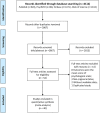The prevalence of psychological disorders among cancer patients during the COVID-19 pandemic: A meta-analysis
- PMID: 35950545
- PMCID: PMC9538248
- DOI: 10.1002/pon.6012
The prevalence of psychological disorders among cancer patients during the COVID-19 pandemic: A meta-analysis
Abstract
Purpose: We aimed to assess the prevalence rate (PR) of depression, anxiety, posttraumatic stress disorder (PTSD), insomnia, distress, and fear of cancer progression/recurrence among patients with cancer during the COVID-19 pandemic.
Methods: Studies that reported the PR of six psychological disorders among cancer patients during the COVID-19 pandemic were searched in PubMed, Embase, PsycINFO, and Web of Science databases, from January 2020 up to 31 January 2022. Meta-analysis results were merged using PR and 95% confidence intervals, and heterogeneity among studies was evaluated using I2 and Cochran's Q test. Publication bias was examined using funnel plots and Egger's tests. All data analyses were performed using Stata14.0 software.
Results: Forty studies with 27,590 participants were included. Pooled results showed that the PR of clinically significant depression, anxiety, PTSD, distress, insomnia, and fear of cancer progression/recurrence among cancer patients were 32.5%, 31.3%, 28.2%, 53.9%, 23.2%, and 67.4%, respectively. Subgroup analysis revealed that patients with head and neck cancer had the highest PR of clinically significant depression (74.6%) and anxiety (92.3%) symptoms. Stratified analysis revealed that patients with higher education levels had higher levels of clinically significant depression (37.2%). A higher level of clinically significant PTSD was observed in employed patients (47.4%) or female with cancer (27.9%).
Conclusion: This meta-analysis evaluated the psychological disorders of cancer patients during the COVID-19 outbreak. Therefore, it is necessary to develop psychological interventions to improve the mental health of cancer patients during the pandemic.
Keywords: COVID-19; PTSD; anxiety; cancer; depression; distress; fear of cancer progression/recurrence; oncology.
© 2022 The Authors. Psycho-Oncology published by John Wiley & Sons Ltd.
Conflict of interest statement
The authors have declared that no conflict of interest exists.
Figures








Similar articles
-
Prevalence of symptoms of depression, anxiety, insomnia, posttraumatic stress disorder, and psychological distress among populations affected by the COVID-19 pandemic: A systematic review and meta-analysis.Psychiatry Res. 2021 Jan;295:113599. doi: 10.1016/j.psychres.2020.113599. Epub 2020 Nov 26. Psychiatry Res. 2021. PMID: 33285346 Free PMC article.
-
Prevalence of mental health problems during the COVID-19 pandemic: A systematic review and meta-analysis.J Affect Disord. 2021 Feb 15;281:91-98. doi: 10.1016/j.jad.2020.11.117. Epub 2020 Dec 3. J Affect Disord. 2021. PMID: 33310451 Free PMC article.
-
Impact of the COVID-19 pandemic on the mental health of hospital staff: An umbrella review of 44 meta-analyses.Int J Nurs Stud. 2022 Jul;131:104272. doi: 10.1016/j.ijnurstu.2022.104272. Epub 2022 Apr 27. Int J Nurs Stud. 2022. PMID: 35576637 Free PMC article.
-
COVID-19 Pandemic Stressors and Psychological Symptoms in Breast Cancer Patients.Curr Oncol. 2021 Jan 8;28(1):294-300. doi: 10.3390/curroncol28010034. Curr Oncol. 2021. PMID: 33430131 Free PMC article.
-
Effects of the Covid-19 Pandemic on the Prevalence of Insomnia, Anxiety, and Depression During Pregnancy: A Systematic Review and Meta-Analysis.Clin Nurs Res. 2022 Nov;31(8):1405-1421. doi: 10.1177/10547738221112748. Epub 2022 Jul 30. Clin Nurs Res. 2022. PMID: 35912813
Cited by
-
An umbrella review of systematic reviews on the impact of the COVID-19 pandemic on cancer prevention and management, and patient needs.Elife. 2023 Apr 4;12:e85679. doi: 10.7554/eLife.85679. Elife. 2023. PMID: 37014058 Free PMC article.
-
Development and validation of a risk prediction model for post-traumatic stress disorder among Chinese breast cancer survivors.Sci Rep. 2025 Mar 17;15(1):9175. doi: 10.1038/s41598-025-92137-y. Sci Rep. 2025. PMID: 40097566 Free PMC article.
-
Longitudinal Changes in Stress and Isolation Among Multi-Ethnic Breast Cancer Survivors Throughout COVID-19.Stress Health. 2025 Jun;41(3):e70063. doi: 10.1002/smi.70063. Stress Health. 2025. PMID: 40530703 Free PMC article.
-
Longitudinal Follow-Up of the Psychological Well-Being of Patients with Colorectal Cancer: Final Analysis of PICO-SM.Curr Oncol. 2024 Dec 11;31(12):7903-7913. doi: 10.3390/curroncol31120582. Curr Oncol. 2024. PMID: 39727705 Free PMC article.
-
Estimation of the prevalence of anxiety during the COVID-19 pandemic: A meta-analysis of meta-analyses.BMC Public Health. 2024 Oct 15;24(1):2831. doi: 10.1186/s12889-024-19729-7. BMC Public Health. 2024. PMID: 39407138 Free PMC article.
References
Publication types
MeSH terms
LinkOut - more resources
Full Text Sources
Medical
Research Materials

